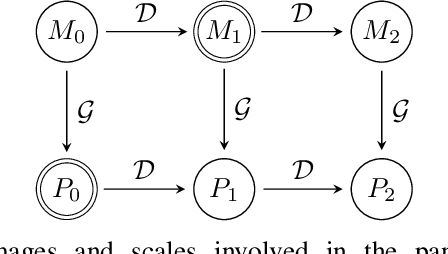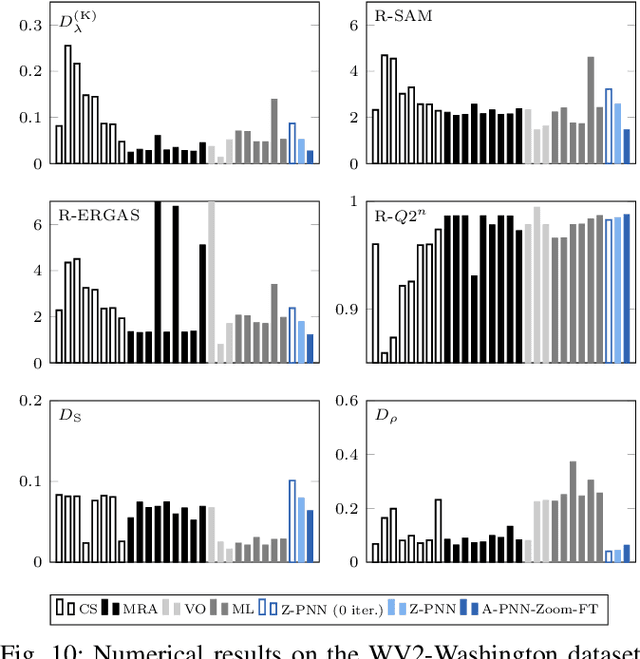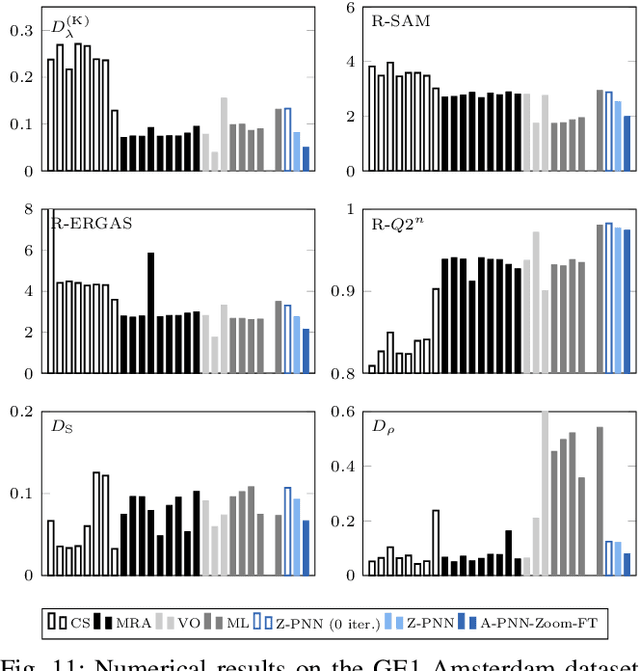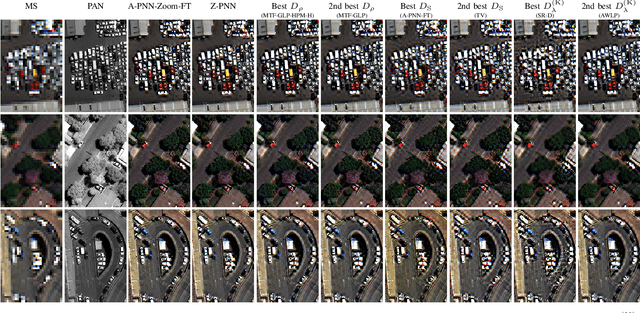Matteo Ciotola
Hyperspectral Pansharpening: Critical Review, Tools and Future Perspectives
Jul 01, 2024Abstract:Hyperspectral pansharpening consists of fusing a high-resolution panchromatic band and a low-resolution hyperspectral image to obtain a new image with high resolution in both the spatial and spectral domains. These remote sensing products are valuable for a wide range of applications, driving ever growing research efforts. Nonetheless, results still do not meet application demands. In part, this comes from the technical complexity of the task: compared to multispectral pansharpening, many more bands are involved, in a spectral range only partially covered by the panchromatic component and with overwhelming noise. However, another major limiting factor is the absence of a comprehensive framework for the rapid development and accurate evaluation of new methods. This paper attempts to address this issue. We started by designing a dataset large and diverse enough to allow reliable training (for data-driven methods) and testing of new methods. Then, we selected a set of state-of-the-art methods, following different approaches, characterized by promising performance, and reimplemented them in a single PyTorch framework. Finally, we carried out a critical comparative analysis of all methods, using the most accredited quality indicators. The analysis highlights the main limitations of current solutions in terms of spectral/spatial quality and computational efficiency, and suggests promising research directions. To ensure full reproducibility of the results and support future research, the framework (including codes, evaluation procedures and links to the dataset) is shared on https://github.com/matciotola/hyperspectral_pansharpening_toolbox, as a single Python-based reference benchmark toolbox.
Band-wise Hyperspectral Image Pansharpening using CNN Model Propagation
Nov 11, 2023



Abstract:Hyperspectral pansharpening is receiving a growing interest since the last few years as testified by a large number of research papers and challenges. It consists in a pixel-level fusion between a lower-resolution hyperspectral datacube and a higher-resolution single-band image, the panchromatic image, with the goal of providing a hyperspectral datacube at panchromatic resolution. Thanks to their powerful representational capabilities, deep learning models have succeeded to provide unprecedented results on many general purpose image processing tasks. However, when moving to domain specific problems, as in this case, the advantages with respect to traditional model-based approaches are much lesser clear-cut due to several contextual reasons. Scarcity of training data, lack of ground-truth, data shape variability, are some such factors that limit the generalization capacity of the state-of-the-art deep learning networks for hyperspectral pansharpening. To cope with these limitations, in this work we propose a new deep learning method which inherits a simple single-band unsupervised pansharpening model nested in a sequential band-wise adaptive scheme, where each band is pansharpened refining the model tuned on the preceding one. By doing so, a simple model is propagated along the wavelength dimension, adaptively and flexibly, with no need to have a fixed number of spectral bands, and, with no need to dispose of large, expensive and labeled training datasets. The proposed method achieves very good results on our datasets, outperforming both traditional and deep learning reference methods. The implementation of the proposed method can be found on https://github.com/giu-guarino/R-PNN
A full-resolution training framework for Sentinel-2 image fusion
Jul 27, 2023Abstract:This work presents a new unsupervised framework for training deep learning models for super-resolution of Sentinel-2 images by fusion of its 10-m and 20-m bands. The proposed scheme avoids the resolution downgrade process needed to generate training data in the supervised case. On the other hand, a proper loss that accounts for cycle-consistency between the network prediction and the input components to be fused is proposed. Despite its unsupervised nature, in our preliminary experiments the proposed scheme has shown promising results in comparison to the supervised approach. Besides, by construction of the proposed loss, the resulting trained network can be ascribed to the class of multi-resolution analysis methods.
Unsupervised Deep Learning-based Pansharpening with Jointly-Enhanced Spectral and Spatial Fidelity
Jul 26, 2023Abstract:In latest years, deep learning has gained a leading role in the pansharpening of multiresolution images. Given the lack of ground truth data, most deep learning-based methods carry out supervised training in a reduced-resolution domain. However, models trained on downsized images tend to perform poorly on high-resolution target images. For this reason, several research groups are now turning to unsupervised training in the full-resolution domain, through the definition of appropriate loss functions and training paradigms. In this context, we have recently proposed a full-resolution training framework which can be applied to many existing architectures. Here, we propose a new deep learning-based pansharpening model that fully exploits the potential of this approach and provides cutting-edge performance. Besides architectural improvements with respect to previous work, such as the use of residual attention modules, the proposed model features a novel loss function that jointly promotes the spectral and spatial quality of the pansharpened data. In addition, thanks to a new fine-tuning strategy, it improves inference-time adaptation to target images. Experiments on a large variety of test images, performed in challenging scenarios, demonstrate that the proposed method compares favorably with the state of the art both in terms of numerical results and visual output. Code is available online at https://github.com/matciotola/Lambda-PNN.
Pansharpening by convolutional neural networks in the full resolution framework
Nov 16, 2021



Abstract:In recent years, there has been a growing interest on deep learning-based pansharpening. Research has mainly focused on architectures. However, lacking a ground truth, model training is also a major issue. A popular approach is to train networks in a reduced resolution domain, using the original data as ground truths. The trained networks are then used on full resolution data, relying on an implicit scale invariance hypothesis. Results are generally good at reduced resolution, but more questionable at full resolution. Here, we propose a full-resolution training framework for deep learning-based pansharpening. Training takes place in the high resolution domain, relying only on the original data, with no loss of information. To ensure spectral and spatial fidelity, suitable losses are defined, which force the pansharpened output to be consistent with the available panchromatic and multispectral input. Experiments carried out on WorldView-3, WorldView-2, and GeoEye-1 images show that methods trained with the proposed framework guarantee an excellent performance in terms of both full-resolution numerical indexes and visual quality. The framework is fully general, and can be used to train and fine-tune any deep learning-based pansharpening network.
Full-resolution quality assessment for pansharpening
Aug 13, 2021



Abstract:A reliable quality assessment procedure for pansharpening methods is of critical importance for the development of the related solutions. Unfortunately, the lack of ground-truths to be used as guidance for an objective evaluation has pushed the community to resort to either reference-based reduced-resolution indexes or to no-reference subjective quality indexes that can be applied on full-resolution datasets. In particular, the reference-based approach leverages on Wald's protocol, a resolution degradation process that allows one to synthesize data with related ground truth. Both solutions, however, present critical shortcomings that we aim to mitigate in this work by means of an alternative no-reference full-resolution framework. On one side we introduce a protocol, namely the reprojection protocol, which allows to handle the spectral fidelity problem. On the other side, a new index of the spatial consistency between the pansharpened image and the panchromatic band at full resolution is proposed. The experimental results show the effectiveness of the proposed approach which is confirmed also by visual inspection.
 Add to Chrome
Add to Chrome Add to Firefox
Add to Firefox Add to Edge
Add to Edge